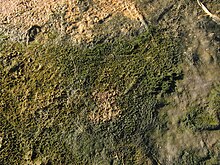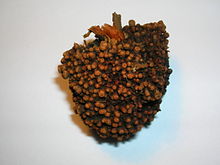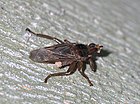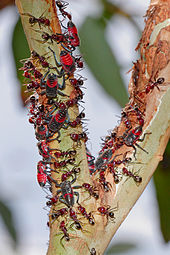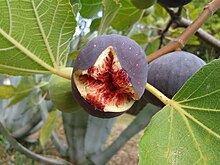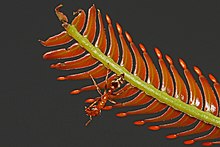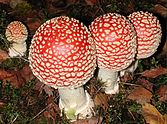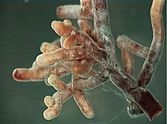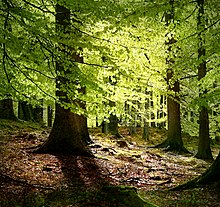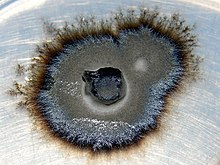The cyanobacterial-algal mat, salty lake on the White Sea seaside
A microbial mat is a multi-layered sheet of microorganisms, mainly bacteria and archaea. Microbial mats grow at interfaces between different types of material, mostly on submerged or moist surfaces, but a few survive in deserts. They colonize environments ranging in temperature from –40 °C to 120 °C. A few are found as endosymbionts of animals.
Although only a few centimetres thick at most, microbial mats
create a wide range of internal chemical environments, and hence
generally consist of layers of microorganisms that can feed on or at
least tolerate the dominant chemicals at their level and which are
usually of closely related species. In moist conditions mats are usually
held together by slimy substances
secreted by the microorganisms, and in many cases some of the
microorganisms form tangled webs of filaments which make the mat
tougher. The best known physical forms are flat mats and stubby pillars
called stromatolites, but there are also spherical forms.
Microbial mats are the earliest form of life on Earth for which there is good fossil evidence, from 3,500 million years ago, and have been the most important members and maintainers of the planet's ecosystems. Originally they depended on hydrothermal vents for energy and chemical "food", but the development of photosynthesis
allow mats to proliferate outside of these environments by utilizing a
more widely available energy source, sunlight. The final and most
significant stage of this liberation was the development of
oxygen-producing photosynthesis, since the main chemical inputs for this
are carbon dioxide and water.
As a result, microbial mats began to produce the atmosphere we know today, in which free oxygen is a vital component. At around the same time they may also have been the birthplace of the more complex eukaryote type of cell, of which all multicellular organisms are composed. Microbial mats were abundant on the shallow seabed until the Cambrian substrate revolution,
when animals living in shallow seas increased their burrowing
capabilities and thus broke up the surfaces of mats and let oxygenated
water into the deeper layers, poisoning the oxygen-intolerant
microorganisms that lived there. Although this revolution drove mats off
soft floors of shallow seas, they still flourish in many environments
where burrowing is limited or impossible, including rocky seabeds and
shores, hyper-saline and brackish lagoons, and are found on the floors
of the deep oceans.
Because of microbial mats' ability to use almost anything as
"food", there is considerable interest in industrial uses of mats,
especially for water treatment and for cleaning up pollution.
Description
Stromatolites are formed by some microbial mats as the microbes slowly move upwards to avoid being smothered by sediment.
Microbial mats have also been referred to as "algal mats" and "bacterial mats" in older scientific literature. They are a type of biofilm that is large enough to see with the naked eye and robust enough to survive moderate physical stresses. These colonies of bacteria form on surfaces at many types of interface, for example between water and the sediment or rock at the bottom, between air and rock or sediment, between soil and bed-rock, etc. Such interfaces form vertical chemical gradients,
i.e. vertical variations in chemical composition, which make different
levels suitable for different types of bacteria and thus divide
microbial mats into layers, which may be sharply defined or may merge
more gradually into each other.
A variety of microbes are able to transcend the limits of diffusion by
using "nanowires" to shuttle electrons from their metabolic reactions
up to two centimetres deep in the sediment – for example, electrons can
be transferred from reactions involving hydrogen sulfide deeper within
the sediment to oxygen in the water, which acts as an electron acceptor.
The best-known types of microbial mat may be flat laminated mats, which form on approximately horizontal surfaces, and stromatolites,
stubby pillars built as the microbes slowly move upwards to avoid being
smothered by sediment deposited on them by water. However, there are
also spherical mats, some on the outside of pellets of rock or other
firm material and others inside spheres of sediment.
Structure
A microbial mat consists of several layers, each of which is dominated by specific types of microorganism, mainly bacteria.
Although the composition of individual mats varies depending on the
environment, as a general rule the by-products of each group of
microorganisms serve as "food" for other groups. In effect each mat
forms its own food chain,
with one or a few groups at the top of the food chain as their
by-products are not consumed by other groups. Different types of
microorganism dominate different layers based on their comparative advantage
for living in that layer. In other words, they live in positions where
they can out-perform other groups rather than where they would
absolutely be most comfortable — ecological relationships between
different groups are a combination of competition and co-operation.
Since the metabolic capabilities of bacteria (what they can "eat" and what conditions they can tolerate) generally depend on their phylogeny
(i.e. the most closely related groups have the most similar
metabolisms), the different layers of a mat are divided both by their
different metabolic contributions to the community and by their
phylogenetic relationships.
In a wet environment where sunlight is the main source of energy, the uppermost layers are generally dominated by aerobic photosynthesizing cyanobacteria (blue-green bacteria whose color is caused by their having chlorophyll), while the lowest layers are generally dominated by anaerobic sulfate-reducing bacteria. Sometimes there are intermediate (oxygenated only in the daytime) layers inhabited by facultative anaerobic
bacteria. For example, in hypersaline ponds near Guerrero Negro
(Mexico) various kind of mats were explored. There are some mats with a
middle purple layer inhabited by photosynthesizing purple bacteria. Some other mats have a white layer inhabited by chemotrophic sulfide-oxidizing bacteria and beneath them an olive layer inhabited by photosynthesizing green sulfur bacteria and heterotrophic bacteria.
However, this layer structure is not changeless during a day: some
species of cyanobacteria migrate to deeper layers at morning, and go
back at evening, to avoid intensive solar light and UV radiation at
mid-day.
Microbial mats are generally held together and bound to their substrates by slimy extracellular polymeric substances
which they secrete. In many cases some of the bacteria form filaments
(threads), which tangle and thus increase the colonies' structural
strength, especially if the filaments have sheaths (tough outer
coverings).
This combination of slime and tangled threads attracts other microorganisms which become part of the mat community, for example protozoa, some of which feed on the mat-forming bacteria, and diatoms, which often seal the surfaces of submerged microbial mats with thin, parchment-like coverings.
Marine mats may grow to a few centimeters in thickness, of which only the top few millimeters are oxygenated.
Types of environment colonized
Underwater microbial mats have been described as layers that live by exploiting and to some extent modifying local chemical gradients, i.e. variations in the chemical composition. Thinner, less complex biofilms live in many sub-aerial environments, for example on rocks, on mineral particles such as sand, and within soil.
They have to survive for long periods without liquid water, often in a
dormant state. Microbial mats that live in tidal zones, such as those
found in the Sippewissett salt marsh, often contain a large proportion of similar microorganisms that can survive for several hours without water.
Microbial mats and less complex types of biofilm are found at
temperature ranges from –40 °C to +120 °C, because variations in
pressure affect the temperatures at which water remains liquid.
They even appear as endosymbionts in some animals, for example in the hindguts of some echinoids.
Ecological and geological importance
Wrinkled Kinneyia-type sedimentary structures formed beneath cohesive microbial mats in peritidal zones. The image shows the location, in the Burgsvik beds of Sweden, where the texture was first identified as evidence of a microbial mat.
Kinneyia-like structure in the Grimsby Formation (Silurian) exposed in Niagara Gorge, New York.
Microbial mats use all of the types of metabolism and feeding strategy that have evolved on Earth—anoxygenic and oxygenic photosynthesis; anaerobic and aerobic chemotrophy (using chemicals rather than sunshine as a source of energy); organic and inorganic respiration and fermentation (i..e converting food into energy with and without using oxygen in the process); autotrophy (producing food from inorganic compounds) and heterotrophy (producing food only from organic compounds, by some combination of predation and detritivory).
Most sedimentary rocks and ore deposits have grown by a reef-like
build-up rather than by "falling" out of the water, and this build-up
has been at least influenced and perhaps sometimes caused by the actions
of microbes. Stromatolites,
bioherms (domes or columns similar internally to stromatolites) and
biostromes (distinct sheets of sediment) are among such
microbe-influenced build-ups.
Other types of microbial mat have created wrinkled "elephant skin"
textures in marine sediments, although it was many years before these
textures were recognized as trace fossils of mats.
Microbial mats have increased the concentration of metal in many ore
deposits, and without this it would not be feasible to mine
them—examples include iron (both sulfide and oxide ores), uranium,
copper, silver and gold deposits.
Role in the history of life
The earliest mats
Microbial mats are among the oldest clear signs of life, as microbially induced sedimentary structures (MISS) formed 3,480 million years ago have been found in western Australia. At that early stage the mats' structure may already have been similar to that of modern mats that do not include photosynthesizing bacteria. It is even possible that non-photosynthesizing mats were present as early as 4,000 million years ago. If so, their energy source would have been hydrothermal vents (high-pressure hot springs around submerged volcanoes), and the evolutionary split between bacteria and archea may also have occurred around this time.
The earliest mats were probably small, single-species biofilms of chemotrophs
that relied on hydrothermal vents to supply both energy and chemical
"food". Within a short time (by geological standards) the build-up of
dead microorganisms would have created an ecological niche for scavenging heterotrophs, possibly methane-emitting and sulfate-reducing organisms that would have formed new layers in the mats and enriched their supply of biologically useful chemicals.
Photosynthesis
It is generally thought that photosynthesis, the biological generation of energy from light, evolved shortly after 3,000 million years ago (3 billion). However an isotope analysis suggests that oxygenic photosynthesis may have been widespread as early as 3,500 million years ago.
The eminent researcher into Earth's earliest life, William Schopf,
argues that, if one did not know their age, one would classify some of
the fossil organisms in Australian stromatolites from 3,500 million years ago as cyanobacteria, which are oxygen-producing photosynthesizers. There are several different types of photosynthetic reaction, and analysis of bacterial DNA indicates that photosynthesis first arose in anoxygenic purple bacteria, while the oxygenic photosynthesis seen in cyanobacteria and much later in plants was the last to evolve.
The earliest photosynthesis may have been powered by infra-red light, using modified versions of pigments
whose original function was to detect infra-red heat emissions from
hydrothermal vents. The development of photosynthetic energy generation
enabled the microorganisms first to colonize wider areas around vents
and then to use sunlight as an energy source. The role of the
hydrothermal vents was now limited to supplying reduced metals into the
oceans as a whole rather than being the main supporters of life in
specific locations. Heterotrophic scavengers would have accompanied the photosynthesizers in their migration out of the "hydrothermal ghetto".
The evolution of purple bacteria, which do not produce or use
oxygen but can tolerate it, enabled mats to colonize areas that locally
had relatively high concentrations of oxygen, which is toxic to
organisms that are not adapted to it.
Microbial mats would have been separated into oxidized and reduced
layers, and this specialization would have increased their productivity.
It may be possible to confirm this model by analyzing the isotope
ratios of both carbon and sulfur in sediments laid down in shallow
water.
The last major stage in the evolution of microbial mats was the appearance of cyanobacteria,
photosynthesizers which both produce and use oxygen. This gave undersea
mats their typical modern structure: an oxygen-rich top layer of
cyanobacteria; a layer of photosynthesizing purple bacteria that could
tolerate oxygen; and oxygen-free, H2S-dominated lower layers of heterotrophic scavengers, mainly methane-emitting and sulfate-reducing organisms.
It is estimated that the appearance of oxygenic photosynthesis
increased biological productivity by a factor of between 100 and 1,000.
All photosynthetic reactions require a reducing agent, but the significance of oxygenic photosynthesis is that it uses water
as a reducing agent, and water is much more plentiful than the
geologically produced reducing agents on which photosynthesis previously
depended. The resulting increases in the populations of
photosynthesizing bacteria in the top layers of microbial mats would
have caused corresponding population increases among the chemotrophic and heterotrophic
microorganisms that inhabited the lower layers and which fed
respectively on the by-products of the photosynthesizers and on the
corpses and / or living bodies of the other mat organisms. These
increases would have made microbial mats the planet's dominant
ecosystems. From this point onwards life itself produced significantly
more of the resources it needed than did geochemical processes.
Oxygenic photosynthesis in microbial mats would also have
increased the free oxygen content of the Earth's atmosphere, both
directly by emitting oxygen and because the mats emitted molecular
hydrogen (H2), some of which would have escaped from the
Earth's atmosphere before it could re-combine with free oxygen to form
more water. Microbial mats thus played a major role in the evolution of
organisms which could first tolerate free oxygen and then use it as an
energy source.
Oxygen is toxic to organisms that are not adapted to it, but greatly
increases the metabolic efficiency of oxygen-adapted organisms — for example anaerobic fermentation produces a net yield of two molecules of adenosine triphosphate, cells' internal "fuel", per molecule of glucose, while aerobic respiration produces a net yield of 36. The oxygenation of the atmosphere was a prerequisite for the evolution of the more complex eukaryote type of cell, from which all multicellular organisms are built.
Cyanobacteria have the most complete biochemical "toolkits" of
all the mat-forming organisms: the photosynthesis mechanisms of both green bacteria and purple bacteria; oxygen production; and the Calvin cycle, which converts carbon dioxide and water into carbohydrates and sugars. It is likely that they acquired many of these sub-systems from existing mat organisms, by some combination of horizontal gene transfer and endosymbiosis
followed by fusion. Whatever the causes, cyanobacteria are the most
self-sufficient of the mat organisms and were well-adapted to strike out
on their own both as floating mats and as the first of the phytoplankton, which forms the basis of most marine food chains.
Origin of eukaryotes
The time at which eukaryotes first appeared is still uncertain: there is reasonable evidence that fossils dated between 1,600 million years ago and 2,100 million years ago represent eukaryotes, but the presence of steranes in Australian shales may indicate that eukaryotes were present 2,700 million years ago.
There is still debate about the origins of eukaryotes, and many of the
theories focus on the idea that a bacterium first became an endosymbiont
of an anaerobic archean and then fused with it to become one organism.
If such endosymbiosis was an important factor, microbial mats would have
encouraged it. There are two possible variations of this scenario:
- The boundary between the oxygenated and oxygen-free zones of a mat would have moved up when photosynthesis shut down at night and back down when photosynthesis resumed after the next sunrise. Symbiosis between independent aerobic and anaerobic organisms would have enabled both to live comfortably in the zone that was subject to oxygen "tides", and subsequent endosymbiosis would have made such partnerships more mobile.
- The initial partnership may have been between anaerobic archea that required molecular hydrogen (H2) and heterotrophic bacteria that produced it and could live both with and without oxygen.
Life on land
Microbial mats from ~1,200 million years ago provide the first evidence of life in the terrestrial realm.
The earliest multicellular "animals"
The Ediacara biota are the earliest widely accepted evidence of multicellular "animals". Most Ediacaran
strata with the "elephant skin" texture characteristic of microbial
mats contain fossils, and Ediacaran fossils are hardly ever found in
beds that do not contain these microbial mats. Adolf Seilacher
categorized the "animals" as: "mat encrusters", which were permanently
attached to the mat;
"mat scratchers", which grazed the surface of the mat without destroying
it; "mat stickers", suspension feeders that were partially embedded in
the mat; and "undermat miners", which burrowed underneath the mat and
fed on decomposing mat material.
The Cambrian substrate revolution
In
the Early Cambrian, however, organisms began to burrow vertically for
protection or food, breaking down the microbial mats, and thus allowing
water and oxygen to penetrate a considerable distance below the surface
and kill the oxygen-intolerant microorganisms in the lower layers. As a
result of this Cambrian substrate revolution, marine microbial mats are confined to environments in which burrowing is non-existent or negligible:
very harsh environments, such as hyper-saline lagoons or brackish
estuaries, which are uninhabitable for the burrowing organisms that
broke up the mats; rocky "floors" which the burrowers cannot penetrate;
the depths of the oceans, where burrowing activity today is at a
similar level to that in the shallow coastal seas before the revolution.
Current status
Although
the Cambrian substrate revolution opened up new niches for animals, it
was not catastrophic for microbial mats, but it did greatly reduce their
extent.
How microbial mats help paleontologists
Most
fossils preserve only the hard parts of organisms, e.g. shells. The
rare cases where soft-bodied fossils are preserved (the remains of
soft-bodied organisms and also of the soft parts of organisms for which
only hard parts such as shells are usually found) are extremely valuable
because they provide information about organisms that are hardly ever
fossilized and much more information than is usually available about
those for which only the hard parts are usually preserved. Microbial mats help to preserve soft-bodied fossils by:
- Capturing corpses on the sticky surfaces of mats and thus preventing them from floating or drifting away.
- Physically protecting them from being eaten by scavengers and broken up by burrowing animals, and protecting fossil-bearing sediments from erosion. For example, the speed of water current required to erode sediment bound by a mat is 20–30 times as great as the speed required to erode a bare sediment.
- Preventing or reducing decay both by physically screening the remains from decay-causing bacteria and by creating chemical conditions that are hostile to decay-causing bacteria.
- Preserving tracks and burrows by protecting them from erosion. Many trace fossils date from significantly earlier than the body fossils of animals that are thought to have been capable of making them and thus improve paleontologists' estimates of when animals with these capabilities first appeared.
Industrial uses
The
ability of microbial mat communities to use a vast range of "foods" has
recently led to interest in industrial uses. There have been trials of
microbial mats for purifying water, both for human use and in fish farming, and studies of their potential for cleaning up oil spills. As a result of the growing commercial potential, there have been applications for and grants of patents relating to the growing, installation and use of microbial mats, mainly for cleaning up pollutants and waste products.
